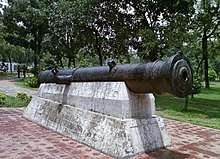Bangladesh Armed Forces
The Bangladesh Armed Forces (Bengali: বাংলাদেশ সশস্ত্র বাহিনী, Bānlādēśa saśastra bāhinī) consists of the three uniformed military services of Bangladesh: the Bangladesh Army, the Bangladesh Navy and the Bangladesh Air Force. Armed forces falls under the jurisdiction of Defence Ministry. The Border Guard Bangladesh (formerly Bangladesh Rifles) and Bangladesh Coast Guard are under the jurisdiction of the Ministry of Home Affairs[8] during peacetime, but during wartime they fall under the command of Bangladesh Army and Bangladesh Navy respectively.
| Bangladesh Armed Forces | |
|---|---|
| বাংলাদেশ সশস্ত্র বাহিনী Bānlādēśa saśastra bāhinī | |
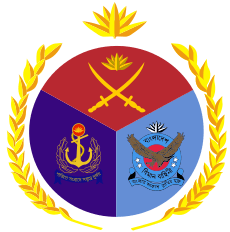 Tri-service Logo of Bangladesh Armed Forces. | |
| Motto | "চির উন্নত মম শির" (de facto) "Ever High is My Head" |
| Founded | 21 November 1971 |
| Current form | 12 January 1972 |
| Service branches | |
| Headquarters | Armed Forces Division Headquarters, Dhaka Cantonment |
| Leadership | |
| Commander-in-Chief | President Abdul Hamid |
| Leader of Armed Forces Division and Minister of Defence | Prime Minister Sheikh Hasina |
| Principal Staff Officer | Md Mahfuzur Rahman |
| Manpower | |
| Military age | 16–21 |
| Conscription | None[1] |
| Active personnel | 204,596 [2][3] |
| Reserve personnel | 63,900[4] |
| Deployed personnel | 6,417 [5] |
| Expenditures | |
| Budget | US$4.53 billion (FY20-21)[6][7] |
| Percent of GDP | 1.3% (FY20-21) |
| Industry | |
| Domestic suppliers | |
| Foreign suppliers | |
| Related articles | |
| History | Bangladesh War of Independence Chittagong Hill Tracts Insurgency Gulf War Saudi Led Coalition against ISIL |
| Ranks | Military ranks of Bangladesh |
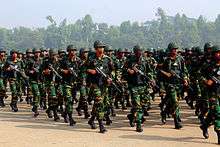
The President of Bangladesh is the Commander-in-chief of the military, the Armed Forces Division (AFD) is the principal administrative organisation by which military policy is formulated and executed; the Ministry of Defence (MoD) does not exercise any operational or policy authority over the Armed Forces. Currently, both AFD and MoD are headed by the Prime Minister of Bangladesh. To coordinate military policy with foreign and intelligence policy, both the president and the prime minister are advised by a six-member advisory board which consists of the three military services' Chiefs of Staff, the Principal Staff Officer of the Armed Forces Division, and military secretaries to the president and the prime minister. The directors general of the NSI, the DGFI and the BGB also serve in an advisory capacity, when invited.[9][10]
The Armed Forces Day is observed on 21 November.[11] Official functions are held at the "Bangabhaban", Armed Forces Division Headquarters, Dhaka Cantonment, and at every military installation throughout the country.[12]
History
Bangladesh's military history is intertwined with the history of a larger region, including present-day India, Pakistan, Nepal, Bhutan and Myanmar. The country was historically part of Bengal– a major medieval power in South Asia and Southeast Asia.
Ancient period
The early military history of the Indian subcontinent included Alexander's invasion of India, which was deterred by the might of Gangaridai Kingdom that was located in present-day Bangladesh, according to most historians. Prince Vijaya of the Vanga Kingdom led a naval expedition to conquer Sri Lanka. The Kalinga War was a notable event of the Mauryan Empire in the eastern Indian subcontinent. The ancient Indian armies included chariots.
Pala period
The Bengal region crystallized as an imperial power during the 8th-11th century Pala Empire. Many of the empire's cities are located in Bangladesh. The Pala military had a large war elephant cavalry, according to Arab historians. The Palas recruited mercenaries from different parts of the Indian subcontinent. Pala conquests extended across North India. The Palas were engaged in a struggle over the Kannauj Triangle with the Gurjara-Pratiharas and Rashtrakutas.
Sultanate period
The Muslim conquest of the Indian subcontinent heralded new military doctrines and hardware, including well-developed artillery. The Delhi Sultanate conquered Bengal in 1204 under the leadership of Bakhtiar Khilji, who later proceeded with an Islamic invasion of Tibet. In Bengal, the Delhi Sultanate displaced the Sena dynasty. Sultan Iwas Khilji (1212-1227) was responsible for founding the Bengal navy during the sultanate period.[13] The chief of the admiralty had various responsibilities, including shipbuilding, transporting personnel, elephants and equipment; recruitment and collecting tolls at ghats.[13] The sultanate period saw the settlement of many military officers and soldiers from North India, Central and West Asia and the Horn of Africa. The settlers included Rajputs and Pashtuns.
In the 14th century, Sultan Shamsuddin Firoz Shah and Hazrat Shah Jalal conquered Sylhet from Raja Gour Govinda;[14] Sultan Fakhruddin Mubarak Shah conquered Chittagong from the Kingdom of Tripura.[15] Shamsuddin Ilyas Shah became known as the Alexander of the eastern subcontinent after sacking Kathmandu, Varanasi and Cuttack.
Bengal Sultanate
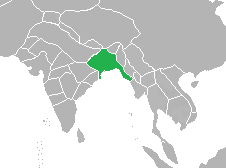
The Bengal Sultanate was a medieval great power and conducted a number of notable campaigns, including the Bengal Sultanate-Delhi Sultanate War, the Bengal Sultanate-Jaunpur Sultanate War, the Reconquest of Arakan, the Bengal Sultanate-Kamata Kingdom War and the Bengal Sultanate-Kingdom of Mrauk U War of 1512-1516. The naval strength of Bengal was notable during the Ilyas Shahi dynasty and the Hussain Shahi dynasty.[13]
Invasion of Sher Shah
Sher Shah Suri conquered Bengal in the 16th century and made it part of the Suri Empire. Sher Shah Suri also renovated the Grand Trunk Road around Sonargaon. His successors later revived the Bengal Sultanate.
Isa Khan's campaigns
After the Bengal Sultanate collapsed in the late 16th-century, the aristocrat Isa Khan led a confederation of zamindars (known as Baro-Bhuyan) to challenge the Mughal invasion of Bengal, often with naval battles on the Padma River, Meghna River and Jangalbari Fort in Egarasindhur. Isa Khan defeated Mughal governors Khan Jahan I in 1578, Shahbaz Khan in 1584 and Man Singh I in 1594. His son and successor Musa Khan continued to lead the confederation until succumbing to the Mughals led by Islam Khan I in 1610.[16]
Mughal period
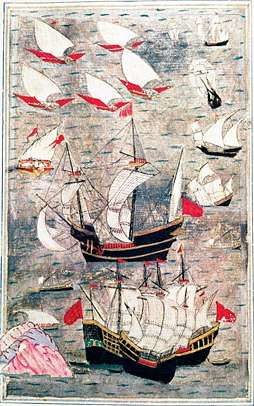
Bengal remained relatively stable and prosperous during the 17th century. A key challenge during the early Mughal period was piracy from the Kingdom of Mrauk U and the Portuguese settlement in Chittagong. In 1666, the Mughal Empire-Kingdom of Mrauk U War expelled the Arakanese and Portuguese from Chittagong. The Mughals also engaged in the Ahom-Mughal conflicts. During the 18th century, Bengal endured the invasions by the Maratha Army- the military of the Maratha Confederacy. It fell to the conquest of the British East India Company after the Battle of Plassey.
Colonial military history
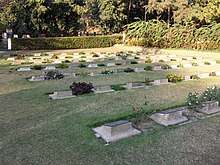
The Bengal Army was formed in 1765 by the British East India Company. The first native infantry was formed in 1757.[13] In the 19th century, the Bengal Army was merged into the British Indian Army under the British Raj. The Royal Indian Navy was formed in 1830. The Royal Indian Air Force was formed in 1932. The Bangladesh Armed Forces were raised from the armed forces of the British Raj, which included the Bengal Regiment and major installations such as the Dhaka Cantonment, Chittagong Cantonment and the Bogra Cantonment.The following includes a list of conflicts which occurred within the territory of Bangladesh under British rule.
- Siege of Calcutta, attempt by the last Nawab of Bengal to recapture Fort William from the East India Company
- Battle of Plassey- defection of Mir Jafar causes defeat of Siraj-ud-Daulah, the last independent Nawab of Bengal
- Anglo-Nepalese War- leads to Treaty of Sugali with Nepal and Treaty of Titalia (signed in Tetulia) with Sikkim
- First Anglo-Burmese War- Burmese forces invade Chittagong Division
- Indian Rebellion of 1857- includes revolt by the Bengal Army in Dhaka, Chittagong and Sylhet
- Bhutan War- Bhutan loses control of Bengal Duars, including parts of Panchagarh District
- Burma Campaign- Allied Forces of World War II stationed in Chittagong, Comilla, Dhaka and Sylhet; Imperial Japanese Air Force bombs Chittagong
There was strong opposition to British involvement against the Turkish War of Independence, as both Mustafa Kemal Atatürk and the Ottoman caliphate enjoyed support in Bengal.
Eastern wing of Pakistan
With the partition of India on 15 August 1947 the territory constituting modern Bangladesh was partitioned from the province of Bengal as East Bengal, joining the newly created state of Pakistan. Ethnic and sectional discrimination prevailed in all sectors of the state. Like other government sectors Bengalis were under-represented in the Pakistan military too. Officers of Bengali origin in the different wings of the armed forces made up just 5% of overall force by 1965.[17] West Pakistanis believed that Bengalis were not "martially inclined" unlike Pashtuns and Punjabis; the "Martial Races" notion was dismissed as ridiculous and humiliating by Bengalis.[17] Moreover, despite huge defence spending, East Pakistan received none of the benefits, such as contracts, purchasing and military support jobs. The Indo-Pakistani War of 1965 over Kashmir also highlighted the sense of military insecurity among Bengalis as only an under-strength infantry division and 15 combat aircraft without tank support were in East Pakistan to thwart any Indian retaliations during the conflict.[18][19]
The East Bengal Regiment was formed on 15 February 1948 following Pakistan's independence and transition from post British rule, composed exclusively of men from the western part of the country. The first East Bengal Regiment was formed of the Bengali members of the British Indian Army Pioneer Corps and Bihar Regiment of the abolished British-Indian army. Between 1948 and 1965, a total of eight battalions of EBR were raised.[20][21]
Bangladesh Liberation War

Following the victory of the Awami League in the 1970 elections, then-president General Yahya Khan refused to appoint its leader Sheikh Mujibur Rahman as the prime minister and launched a brutal attack named Operation Searchlight on the civilians of the then East Pakistan, using the Pakistani army to repress political movements.[22] Figures of people killed by Pakistani forces vary from a minimum of around 300,000 to a maximum of around 3 million.[23][24] Responding to Mujib's call for rebellion, many students, workers and other civilians mutinied against Pakistan and raised the Mukti Bahini, a guerrilla force. Later on, many Bengali officers and units from Pakistan Army and East Pakistan Rifles mutinied against their West Pakistani counterparts and joined the Mukti bahini.[25][26][27] On 17 April 1971, Muhammad Ataul Gani Osmani took oath as the commander-in-chief of Mukti bahini. While the war raged on, the necessity of a well-trained armed force was always felt. During the first Bangladesh Sector Commanders Conference, held from 11 to 17 July 1971, the Bangladesh Forces started its journey composed of the revolting Bengali members of the Pakistan Army and EPR.[28] In this historic conference the field command structure, sector reorganization, reinforcement, appointment of field commanders and tactics of warfare were decided upon and carried out. On 21 November 1971, the Bangladesh Forces was divided into three separate services as Bangladesh Army, Bangladesh Navy and Bangladesh Air Force.
The Bangladesh Forces received modest assistance from the Indian Government soon after the start of the war.[29] On 3 December 1971, India-Pakistan war broke out and Indian troops enter Bangladesh allied with the Bangladesh Armed Forces.[30] On 16 December 1971 the Pakistani Military force in Bangladesh surrender to a joint force of Indian and Bangladesh forces.[31]
Post-independence
The newly formed Bangladeshi armed forces incorporated some of the units and guerrillas of the Mukti Bahini.[32] Gen. Osmani, who had led the Mukti Bahini was appointed the General of the Bangladesh armed forces.[33] For many years, there was active discrimination in favour of the inductees from the Mukti Bahini against those Bengali officers who had continued service in the Pakistani armed forces or had been detained in West Pakistan.[32][34] A group of angered officers assassinated the president Sheikh Mujib on 15 August 1975 and established a regime with politician Khondaker Mostaq Ahmed as President of Bangladesh and new army chief Maj. Gen. Ziaur Rahman.[34] The military itself was subject of divisions as Mujib's assassins were overthrown by the pro-Mujib Brig. Gen. Khaled Mosharraf on 3 November, who himself was soon overthrown by a socialist group of officers under Col. Abu Taher on 7 November who returned Ziaur Rahman to power—an event now called the Sipoy-Janata Biplob (Soldiers and People's Coup).[35] Under the presidency of Ziaur Rahman, the military was reorganised to remove conflicts between rival factions and discontented cadre.[36] However, Ziaur Rahman was himself overthrown in a 1981 coup attempt,[37] and a year later, Lt. Gen. Hossain Mohammad Ershad took power from the elected government of president Abdus Sattar. The military remained the most important force in national politics under the regimes of Ziaur Rahman and later Hossain Mohammad Ershad until democracy was restored in 1991.[36]
Modern period
Having relied primarily on India and Soviet Union for military aid, Bangladesh has also developed military ties with the People's Republic of China and the United States. The Bangladesh Army has been actively involved in United Nations Peace Support Operations (UNPSO). During the first Gulf War in 1991, the Bangladesh Army sent a 2,193 member team to monitor peace in Saudi Arabia and Kuwait. The Bangladesh Army also participated in peace keeping activities in Namibia, Cambodia, Somalia, Uganda, Rwanda, Mozambique, former Yugoslavia, Liberia, Haiti, Tajikistan, Western Sahara, Sierra Leone, Kosovo, Georgia, East Timor, Congo, Côte d'Ivoire and Ethiopia. As of October 2008, Bangladesh remained the second largest contributor with 9,800 troops in the UN Peacekeeping forces.
Until a peace accord was signed in 1997, the Bangladeshi military engaged in counterinsurgency operations in the Chittagong Hill Tracts fighting the Shanti Bahini separatist group. In 2001, Bangladeshi military units engaged in clashes with the Indian Border Security Force (BSF) along the northern border.[38] Controversy also emerged over possible links maintained by the Bangladeshi military and intelligence agencies with Islamic terrorist groups and anti-India secessionist outfits.[39][40][41] Several projects and schemes aiming to expand and modernize the Bangladeshi armed forces were launched by the government of former Prime Minister Begum Khaleda Zia.
Forces Goal 2030 was launched by the government of Prime Minister Sheikh Hasina to secure new equipment for the Bangladeshi military.
Bangladesh-Myanmar border
Standoffs have occasionally occurred at the Bangladesh-Myanmar border, including in 1991 and 2008. Most of the standoffs took place when Myanmar attempted to force Rohingyas into Bangladesh. In 2008, the two countries deployed warships after Myanmar attempted to explore a disputed Bay of Bengal seabed for oil and gas. The dispute was resolved at an international tribunal in 2012. Bangladesh and Myanmar have also conducted counter-insurgency operations on the border.
- 2008 Bangladesh–Myanmar naval standoff
- 2015 Bangladesh-Arakan Army border clash
Medals and decorations
The following are the various gallantry, service and war medals of the Bangladesh Armed Forces.[42][43][44][45][46]
Gallantry awards

Service medals


Current deployments
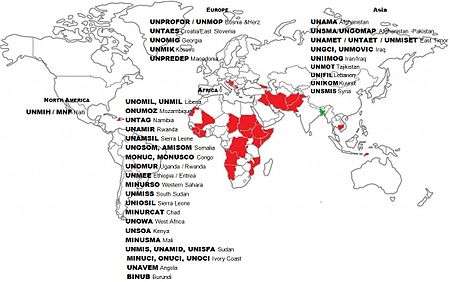
Bangladesh has consistently made large contributions to United Nations peacekeeping operations. As of May 2007, Bangladesh had major deployments in Democratic Republic of Congo, Liberia, Lebanon, Sudan, Timor-Leste and Cote d'Ivoire.[47] With 10,736 troops deployed, it ranks first in personnel contributions to UN peacekeeping.[48] The government declined to participate in Iraq on a request from the United States. The deployment to Liberia began in October 2003 and has remained at a level of about 3200 who are participating in peacekeeping, charitable activities and infrastructure development.
Training
Officers are trained and educated for three years at the Bangladesh Military Academy, Bhatiary, Bangladesh Naval Academy at Patenga, both located in Chittagong and Bangladesh Air Force Academy located in Jessore. For advance training during their career, officers are sent to Bangladesh Defence Services Command and Staff College at Mirpur, while senior officers attend the National Defense University for Armed Forces War Course. Many attend the Military Institute of Science and Technology while serving. Officers of the Army Medical Corps are recruited after graduation from both military or civil medical colleges. They undergo basic military training at Bangladesh Military Academy followed by professional training in medical corps centre and Armed Forces Medical Institute. Recently cadets of Armed Forces Medical College also started joining the services directly.[49]
Ranks
Bangladesh military ranks, essentially corresponds to those used by the armed forces of the commonwealth nations.
The rank insignia for commissioned officers for the Armed forces respectively.
| Equivalent NATO code | OF-10 | OF-9 | OF-8 | OF-7 | OF-6 | OF-5 | OF-4 | OF-3 | OF-2 | OF-1 | OF(D) and student officer | |||||||||||||||||||||||||
|---|---|---|---|---|---|---|---|---|---|---|---|---|---|---|---|---|---|---|---|---|---|---|---|---|---|---|---|---|---|---|---|---|---|---|---|---|
(Edit) |
No equivalent |  |
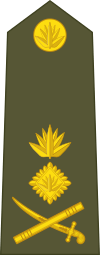 |
 |
 |
 |
 |
 |
 |
 |
 |
 | ||||||||||||||||||||||||
| General | Lieutenant general | Major general | Brigadier general | Colonel | Lieutenant colonel | Major | Captain | Lieutenant | Second lieutenant | Officer cadet | ||||||||||||||||||||||||||
(Edit) |
No equivalent |  |
 |
 |
 |
 |
 |
 |
 |
 |
 |
 |
||||||||||||||||||||||||
| Admiral | Vice Admiral | Rear Admiral | Commodore | Captain | Commander | Lieutenant Commander | Lieutenant | Sub-lieutenant | Acting Sub-lieutenant | Midshipman | Officer Cadet | |||||||||||||||||||||||||
(Edit) |
No equivalent |  |
 |
 |
 |
 |
 |
 |
 |
 |
 |
 | ||||||||||||||||||||||||
| Air Chief Marshal | Air Marshal | Air Vice-Marshal | Air Commodore | Group Captain | Wing Commander | Squadron Leader | Flight Lieutenant | Flying Officer | Pilot Officer | Officer cadet | ||||||||||||||||||||||||||
| Equivalent NATO code | OF-10 | OF-9 | OF-8 | OF-7 | OF-6 | OF-5 | OF-4 | OF-3 | OF-2 | OF-1 | OF(D) and student officer | |||||||||||||||||||||||||
Organization
Regular forces
- Bangladesh Army (Bangladesh Sena Bahini)
- Bangladesh Navy (Bangladesh Nou-bahini)
- Bangladesh Air Force (Bangladesh Biman Bahini)
Para-military forces
- Bangladesh National Cadet Corps (BNCC)
- Border Guard Bangladesh (BGB)
- Bangladesh Coast Guard (BCG)
Civil forces and reserves
Specialized forces
- President Guard Regiment (PGR) – Bangabhaban (President's Office)
- Special Security Force (SSF) – Prime Minister's Office
- Para-Commando Brigade(The Cheetahs) – Under Command AHQ, Dhaka, Bangladesh Army
- Special Warfare Diving And Salvage (SWADS) – Bangladesh Navy
- 41 squadron airborne – Bangladesh Air Force
Military districts
- Savar Area Command
- Ghatail Area Command
- Bogra Area Command
- Rangpur Area Command
- Comilla Area Command
- Chittagong Area Command
- Ramu Area Command
- Jessore Area Command
- Sylhet Area Command
- Barisal Area Command
- Army Training and Doctrine Command
- Army Logistics Area
- HQ All Military Lands
- HQ Cantonment Boards
- HQ's of Bangladesh Army
- Armed Forces Division (AFD)
- 46 Independent Infantry Brigade
- 24 Independent Engineers Brigade
- 18 Engineers Brigade
- 6 Air Defence Brigade
- 14 Army Signal Brigade
- HQ, President's Guard Regiment
- Inter Services Selection Board (ISSB)
- HQ's Armed Forces Medical and Nursing Corps (AFMNC)
- Central Officer's Record Office (CORO)
- HQ's Armed Forces Recruiting Centre (AFRC)
- HQ's Cantonment Public Schools
- HQ's Armed Forces Library
- Armed Forces Institute of Pathology (AFIP)
- National Armed Forces Cemetery
Educational and training institutes
- Army Institute of Business Administration (Army IBA), Savar Cantonment, Dhaka
- Bangladesh Military Academy (BMA), Bhatiary, Chittagong
- School of Infantry and Tactics (SI&T), Jalalabad Cantonment, Sylhet.
- Defence Services Command and Staff College (DSC&SC), Mirpur Cantonment, Dhaka.
- National Defence College (NDC), Mirpur Cantonment, Dhaka.
- Military Institute of Science and Technology (MIST), Mirpur Cantonment, Dhaka.
- Armoured Corps Centre & School (ACC&S), Majira Cantonment, Bogra.[50]
- Engineer Centre and School of Military Engineering, Quadirabad Cantonment, Natore.
- Signal Training Centre and School, Jessore Cantonment, Jessore.
- Army Service Corp Centre & School, Jahanabad Cantonment, Khulna.
- Army Medical Corps Centre & School, Shaheed Salahuddin Cantonment, Ghatail, Tangail.
- Ordnance Corps Centre & School, Rajendrapur Cantonment, Gazipur
- Bangladesh Institute of Peace Support Operation Training (BIPSOT), Rajendrapur Cantonment, Gazipur.
- Electrical and Mechanical Engineering Centre and School, Saidpur Cantonment, Nilphamari.
- Corps of Military Police Centre and School, Shahid Salahuddin Cantonment, Ghatail, Tangail.
- Army School of Education and Administration, Shahid Salahuddin Cantonment, Ghatail, Tangail.
- Army School of Physical Training and Sports (ASPTS), Dhaka Cantonment, Dhaka.
- Army School of Music, Chittagong Cantonment, Chittagong.
- Armed Forces Medical College (AFMC), Dhaka Cantonment, Dhaka.
- Army Medical College Chattogram (AMCC)
- Army Medical College Comilla (AMCCo)
- Army Medical College Bogra (AMCB)
- Army Medical College Jessore (AMCJ)
- Army Medical College Rangpur(AMCR)
Artillery Centre and School, Halishahar, Chittagong.
- School of Military Intelligence, Moynamoti Cantonment, Comilla.
- East Bengal Regimental Centre, Chittagong Cantonment, Chittagong.
- Bangladesh Infantry Regimental Centre, Rajshahi Cantonment, Rajshahi.
- Non Commissioned Officers Academy, Majira Cantonment, Bogra.[51]
- Bangladesh University Of Professionals(BUP), Mirpur Cantonment, Dhaka.
Training institutes of Bangladesh Air Force
- Bangabandhu Sheikh Mujibur Rahman Aviation and Aerospace University[52]
- Bangladesh Air Force Academy (BAFA), Jessore.
- Flying Instructors School (FIS), Bogra.
- Command and Staff Training Institute (CSTI), Dhaka.
- Flight Safety Institute (FSI), Dhaka.
- Officers' Training School (OTS), Jessore.
- Aero-Medical Institute (AMI), Dhaka.
- Fighter Controller Training Unit (FCTU), Dhaka.
- School of Physical Fitness (SOPF), Dhaka.
- Recruits Training School (RTS), Chittagong.
- Training Wing (TW), Chittagong.
- Mechanical Transport Driving School (MTDS), Shamsher Nagar.
- Helicopter Simulator Institute BAF(HSI), Dhaka
Training Institutes of Bangladesh Navy
- Bangladesh Naval Academy (BNA), Chittagong.
- BNS Shaheed Moazzem, Kaptai, Rangamati Hill District, Chittagong. (For Sailor's Advanced Training)
- BNS ISA KHAN, Chittagong (Home of 13 Different Training Schools)
- BNS TITUMIR, Khulna (Home of New Entry Training School (NETS) and School of Logistics and Management (SOLAM))
- School of Maritime Warfare & Tactics, Chittagong Port.
Army Cantonments
Cantonments are where Bangladesh Army personnel work, train, and live.[53]
- Alikadam Cantonment (Bandarban)
- Bandarban Cantonment (Bandarban)
- Bangladesh Military Academy (Chittagong District)
- Bogra Cantonment (Bogra)
- Chittagong Cantonment (Chittagong)
- Comilla Cantonment (Comilla)
- Dhaka Cantonment (Dhaka)
- Dighinala Cantonment (Khagrachari)
- Halishahar Cantonment (Chittagong)
- Jahanabad Cantonment (Khulna)
- Jahangirabad Cantonment (Bogra)
- Jalalabad Cantonment (Sylhet)
- Jamuna Cantonment (Bhuapur, Tangail)
- Jessore Cantonment (Jessore)
- Kaptai Cantonment (Kaptai)
- Khagrachari Cantonment (Khagrachari)
- Kholahati Cantonment (Parbatipur, Dinajpur)
- Mirpur Cantonment (Mirpur)
- Mymensingh Cantonment (Mymensingh)
- Padma Cantonment (Munshiganj and Shariatpur)
- Postogola Cantonment (Dhaka)
- Qadirabad Cantonment (Natore)
- Rajendrapur Cantonment (Gazipur)
- Rajshahi Cantonment (Rajshahi)
- Ramu Cantonment (Ramu, Cox's Bazar)
- Rangamati Cantonment (Rangamati)
- Rangpur Cantonment (Rangpur)
- Saidpur Cantonment (Saidpur, Rangpur)
- Savar Cantonment (Savar)
- Shahid Salahuddin Cantonment (Ghatail, Tangail)
- Sheikh Hasina cantonment (Patuakhali)
Air Force bases
- BAF Base Bangabandhu (Dhaka)
- BAF Base Cox's Bazar (Cox's Bazar)
- BAF Base Khademul Bashar (Dhaka)
- BAF Base Matiur Rahman (Jessore)
- BAF Base Paharkanchanpur (Tangail)
- BAF Base Zahurul Haq (Chittagong)
Navy bases
- BNS Haji Mohshin (Dhaka)
- BNS Issa Khan (Chittagong)
- BNS Shaheed Moazzem (Rangamati)
- BNS Sheikh Hasina (Cox's Bazar)
- BNS Sher-e-Bangla (Patuakhali)
- BNS Titumir (Khulna)
- BNS Ulka (Chittagong)
- BNS Vatiary (Chittagong)
- BNS Mongla (Bagerhat)
Future modernization plans
Bangladesh has made a long term modernisation plan for its Armed Forces named Forces Goal 2030.[54] The plan includes the modernization and expansion of all equipment and infrastructures and providing enhanced training.[54]
Gallery
.jpg) Humanitarian operation after Cyclone Sidr
Humanitarian operation after Cyclone Sidr_261.jpg) Bangladesh Army soldiers unload a shipment of bottled water for cyclone victims.
Bangladesh Army soldiers unload a shipment of bottled water for cyclone victims._(Special_Operations_Capable)_at_Barisal_Airfield.jpg) Bangladesh Army personnel unloading boxes of food for cyclone victims at Barisal
Bangladesh Army personnel unloading boxes of food for cyclone victims at Barisal Bangladesh Army personnel and armoured personnel carrier in UN peacekeeping mission
Bangladesh Army personnel and armoured personnel carrier in UN peacekeeping mission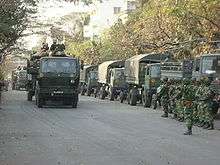 Army soldiers on active duty in Dhaka
Army soldiers on active duty in Dhaka Army personnel at Victory Day Parade 2012
Army personnel at Victory Day Parade 2012.jpg) Bangladesh Army's main battle tanks at Victory Day Parade 2017
Bangladesh Army's main battle tanks at Victory Day Parade 2017.jpg) Bangladesh Army's MBT-2000 main battle tank
Bangladesh Army's MBT-2000 main battle tank Bangladesh Army's Type-69 IIG main battle tank
Bangladesh Army's Type-69 IIG main battle tank AS365 Dauphin helicopter of Bangladesh Army Aviation Group
AS365 Dauphin helicopter of Bangladesh Army Aviation Group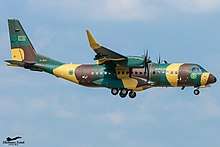 C-295 transport aircraft of Bangladesh Army
C-295 transport aircraft of Bangladesh Army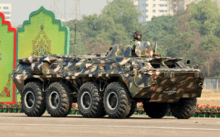 BTR-80 armoured personnel carrier of Bangladesh Army
BTR-80 armoured personnel carrier of Bangladesh Army- Bangladesh navy frigate BNS Somudra Joy (F-28) at Pearl Harbor in 2013
.jpg) BNS Bangabandhu (F-25) guided missile frigate at sea.
BNS Bangabandhu (F-25) guided missile frigate at sea.- BNS Osman (F-18) guided missile frigate at sea
 Bangladesh navy frigate BNS Somudra Avijan (F-29) at Alameda, California, in 2015
Bangladesh navy frigate BNS Somudra Avijan (F-29) at Alameda, California, in 2015.jpg) Bangladesh navy patrol ship BNS Sangu
Bangladesh navy patrol ship BNS Sangu%2C_right%2C_and_Sangu_(P-713).jpg) Bangladesh Navy frigate and OPV at Exercise CARAT 2012 conducted by US Pacific Fleet
Bangladesh Navy frigate and OPV at Exercise CARAT 2012 conducted by US Pacific Fleet%2C_debriefs_Bangladesh_Navy_Special_War.jpg)
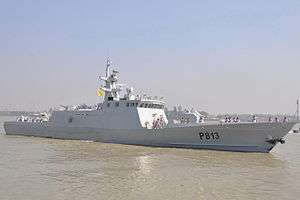 BNS Nirmul Durjoy-class patrol craft of Navy
BNS Nirmul Durjoy-class patrol craft of Navy Flypast of victory day, 2016 at National Parade Ground
Flypast of victory day, 2016 at National Parade Ground.jpg) Bangladesh Air Force Mikoyan MiG-29 multirole fighter aircraft
Bangladesh Air Force Mikoyan MiG-29 multirole fighter aircraft.jpg) Bangladesh Air Force Mig-29 rushes of for a short mission
Bangladesh Air Force Mig-29 rushes of for a short mission.jpg) Chengdu F-7 BG fighter aircraft of Bangladesh Air Force
Chengdu F-7 BG fighter aircraft of Bangladesh Air Force.jpg) Lockheed Martin C-130J Super Hercules military transport aircraft of Bangladesh Air Force
Lockheed Martin C-130J Super Hercules military transport aircraft of Bangladesh Air Force Lockheed C-130B military transport aircraft of Bangladesh Air Force
Lockheed C-130B military transport aircraft of Bangladesh Air Force.jpg) Bangladesh Air Force Antonov An-32 (converted bomber)
Bangladesh Air Force Antonov An-32 (converted bomber).png) Mil Mi-171Sh assault helicopter of Bangladesh Air Force
Mil Mi-171Sh assault helicopter of Bangladesh Air Force.jpg) Bangladesh Air Force Mil Mi-17 helicopter at UN Peacekeeping mission
Bangladesh Air Force Mil Mi-17 helicopter at UN Peacekeeping mission.jpg) Bangladesh Air Force aircraft during an exercise with US Air Force
Bangladesh Air Force aircraft during an exercise with US Air Force_paratroopers_descend_from_a_U.S._Air_Force_C-130_Hercules_aircraft_over_Bangladesh_during_exercise_Cope_South_14_Nov._12%2C_2013_131112-F-SI013-572.jpg) Bangladesh Air Force paratroopers descend from a C-130 aircraft
Bangladesh Air Force paratroopers descend from a C-130 aircraft
See also
- Government of Bangladesh
- Military coups in Bangladesh
- Forces Goal 2030
References
- "South Asia :: Bangladesh — The World Factbook". un.org. CIA.
- "সশস্ত্র বাহিনীর সদস্য সংখ্যা ২ লাখ ৪ হাজার ৫৯৬ জন". The Daily Sangram. Retrieved 30 December 2019.
- "সশস্ত্র বাহিনীর সদস্য ২ লাখ ৪ হাজার ৫৯৬ জন". banglanews24.com. Retrieved 30 December 2019.
- The Military Balance 2009. Routledge. 17 January 2018. ISBN 9781351225939. Retrieved 30 December 2019.
- "Troop and police contributors". United Nations Peacekeeping. Retrieved 30 December 2019.
- "প্রতিরক্ষা খাতে বরাদ্দ ৩৪ হাজার ৪২৭ কোটি টাকা". Jugantor. Retrieved 11 June 2020.
- "প্রতিরক্ষা খাতে বাজেট বৃদ্ধি". banglainsider.com. Retrieved 11 June 2020.
- "Ministry of Home Affairs | Government of the People's Republic of Bangladesh". mha.gov.bd. 16 December 1971. Retrieved 21 May 2013.
- "Hasina attends office at Armed Forces Division". The Daily Star. 15 January 2009. Retrieved 3 October 2017.
- "Lt Gen Mahfuzur new principal staff officer of Armed Forces Division". The Daily Star. 3 February 2016. Retrieved 3 October 2017.
- "Armed Forces Day today". The Daily Star. 21 November 2015. Retrieved 3 October 2017.
- "Significance of Armed Forces Day". The Daily Star. 22 November 2009. Retrieved 3 October 2017.
- "Military". Banglapedia.
- Muhammad Mojlum Khan (21 October 2013). The Muslim Heritage of Bengal: The Lives, Thoughts and Achievements of Great Muslim Scholars, Writers and Reformers of Bangladesh and West Bengal. Kube Publishing Limited. pp. 25. ISBN 978-1-84774-062-5.
- "Fakhruddin Mubarak Shah - Banglapedia". En.banglapedia.org. 5 May 2014. Retrieved 27 September 2017.
- "Isa Khan - Banglapedia". En.banglapedia.org. 5 May 2014. Retrieved 27 September 2017.
- Heitzman, James; Worden, Robert, eds. (1989). "Pakistan Era". Bangladesh: A Country Study. Washington, D.C.: Federal Research Division, Library of Congress. p. 207.
- Demons of December — Road from East Pakistan to Bangladesh
- Jahan, Rounaq (1972). Pakistan: Failure in National Integration. Columbia University Press. pp. 166–167. ISBN 0-231-03625-6.
- "Maj Abdul Gani". The Daily Star. 11 November 2014. Retrieved 6 October 2016.
- "The 1965 War: A view from the east". Rediff.com. Retrieved 13 December 2017.
- Bose, Sarmila (8 October 2005). "Anatomy of Violence: Analysis of Civil War in East Pakistan in 1971". Economic and Political Weekly. Archived from the original on 1 March 2007.
- Matthew White's Death Tolls for the Major Wars and Atrocities of the Twentieth Century
- Virtual Bangladesh : History : The Bangali Genocide, 1971 Archived 23 July 2011 at the Wayback Machine
- Heitzman, James; Worden, Robert, eds. (1989). "Zia's regime". Bangladesh: A Country Study. Washington, D.C.: Federal Research Division, Library of Congress. pp. 37–40.
- Ahmed, Helal Uddin (2012). "Mukti Bahini". In Islam, Sirajul; Jamal, Ahmed A. (eds.). Banglapedia: National Encyclopedia of Bangladesh (Second ed.). Asiatic Society of Bangladesh.
- Uddin, Syed Mohd. Saleh (2012). "Bangladesh Air Force". In Islam, Sirajul; Jamal, Ahmed A. (eds.). Banglapedia: National Encyclopedia of Bangladesh (Second ed.). Asiatic Society of Bangladesh.
- Kawakita, Atsuyo. "Bangladesh War of Independence. The history of Bangladesh Independence War". www.bengalrenaissance.com. Retrieved 3 October 2017.
- "Unfinished agenda of the Liberation War". The Daily Star. 26 March 2016. Retrieved 3 October 2017.
- "The Tangail Landings: A signal for victory". The Daily Star. 26 March 2015. Retrieved 3 October 2017.
- "Witnessing the surrender". The Daily Star. 16 December 2012. Retrieved 3 October 2017.
- Heitzman, James; Worden, Robert, eds. (1989). "Postindependence Period". Bangladesh: A Country Study. Washington, D.C.: Federal Research Division, Library of Congress. p. 211.
- Khan, Muazzam Hussain (2012). "Osmany, General Mohammad Ataul Ghani". In Islam, Sirajul; Jamal, Ahmed A. (eds.). Banglapedia: National Encyclopedia of Bangladesh (Second ed.). Asiatic Society of Bangladesh.
- Heitzman, James; Worden, Robert, eds. (1989). "Mujib coup". Bangladesh: A Country Study. Washington, D.C.: Federal Research Division, Library of Congress. pp. 32–36.
- Islam, Syed Serajul (May 1984). "The State in Bangladesh under Zia (1975–81)". Asian Survey. University of California Press. 24 (5): 556–573. doi:10.1525/as.1984.24.5.01p0162r. JSTOR 2644413.
- Heitzman, James; Worden, Robert, eds. (1989). "Restoration of Military Rule". Bangladesh: A Country Study. Washington, D.C.: Federal Research Division, Library of Congress. pp. 36–37.
- "Bangladesh: Death at Night". Time. 8 June 1981. Retrieved 10 September 2006.
- "India-Bangladesh border conflict". BBC News. 18 April 2001.
- Saikia, Jaideep (July 2003). "Terror Sans Frontiers: Islamic Militancy in North East India" (PDF). The Program in Arms Control & Domestic and International Security at the University of Illinois at Urbana-Champaign. Archived from the original (PDF) on 15 April 2015.
- ULFA, an agent for India's enemies
- Parthasarathy, G. (3 November 2005). "The Bangladesh Challenge". The Hindu Business Line (Opinion).
- "ODM of Bangladesh: Ribbon Chart". www.medals.org.uk.
- http://www.medals.org.uk/bangladesh/bangladesh-text.htm Text List of Ribbons
- http://www.jeanpaulleblanc.com/Bangladesh.htm Orders, Decorations and Medals of Bangladesh
- "Medals". Archived from the original on 1 July 2014. Retrieved 14 July 2014. Army Medal Lists: Official
- "Asian Medals: Bangladesh". Militaria. Archived from the original on 22 December 2015. Retrieved 15 December 2015.
- UN Mission's Summary detailed by Country, Monthly Summary of Contributors of Military and Civilian Police Personnel, Department of Peacekeeping Operations, United Nations, 31 May 2007
- Ranking of Military and Police Contributions to UN Operations, Monthly Summary of Contributors of Military and Civilian Police Personnel, Department of Peacekeeping Operations, United Nations, 31 May 2007
- "Bangladesharmy.org". Bangladesharmy.org. Archived from the original on 1 May 2013. Retrieved 21 May 2013.
- "Armoured Corps Center & School". www.army.mil.bd. Bangladesh Army. Archived from the original on 14 July 2014. Retrieved 14 July 2014.
- Singh, Ravi Shekhar Narain (2005). Asian Strategic and Military Perspective. New Delhi: Lancer Publishers. p. 25. ISBN 817062245X.
- BSMR aviation and aerospace university bill passed | The Daily Star
- "Cantonment Locations". www.joinbangladesharmy.mil.bd. Bangladesh Army. Archived from the original on 18 June 2015. Retrieved 14 July 2014.
- "Forces Goal 2030 to be implemented in four phases: PM". New Age. 28 February 2013. Retrieved 15 March 2014.
Bibliography
- International Institute for Strategic Studies (14 February 2018). The Military Balance 2018. London: Routledge. ISBN 9781857439557.
External links
| Wikimedia Commons has media related to Military of Bangladesh. |
